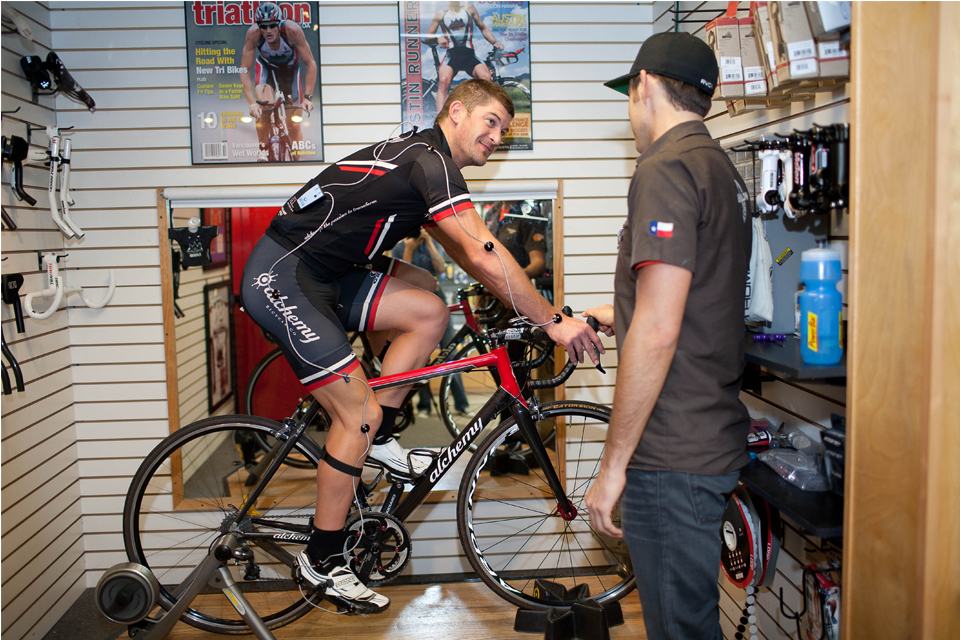Finding Your Proper Fit

There is no dispute that a proper bike fit is the most important factor in getting an athlete in the most comfortable, efficient, and aerodynamic position on a bike. Whether the rider is a cyclist, triathlete, young or old, competitive or commuter, a proper bike fit is something that every rider should have. Considering that most avid cyclists spend more time on their bikes each week than almost any other place, it is important to have a great fit to reduce (or even eliminate) the risk of injury. As cyclists progress through their careers, they can become more fit, lean, and flexible. As the riders’ physical looks—and even their goals—change, so should the fit of the bike.
If you have been riding for a couple years and are still riding the same fit that you had when you first started, it is probably time to have your fit reevaluated or even optimized. It is not uncommon for a cyclist to develop a different pedaling style; for example, if the rider starts to develop more plantar flexion (toe-down) through the pedal stroke, an increase in saddle height might be required. Even if a person is new to cycling, it is important to have a proper bike fit to keep the rider in the sport and to not develop bad habits early on.
Cycling by nature requires continual repetition of the same motion over a prolonged period of time. An average cadence of 90 rpms over an easy one-hour ride comes to 5,400 pedal strokes. Extrapolate that over a six-hour ride and you can see how easy it is to get an over-use injury. Your legs extend and flex at the same angle every pedal stroke. Your knees track in the same plane every pedal stroke. If any part of your fit is off by even just a few millimeters, causing a tilted pelvis, leg length discrepancy, or even handle bars that are not at the correct height, problems can arise over time. Lower back pain, tightness between the shoulder blades, pain in the knees, numb toes, saddle sores—these can all be symptoms of a poor bike fit. In our shop, we see customers who suffer from knee pain (mostly anterior). These problems can stem from something as simple as a saddle being too low or from something more complicated, such as a leg-length discrepancy or twisted pelvis that has never been addressed in previous fits. It is possible to “Band-Aid” problems by taking a pain reliever or icing the troubled spot, but these issues usually stem from a bad marriage between rider and bike. That is why it is important to address the origin of the problems and fix it or point the rider in the direction to get the problem solved, whether it be visiting a physical therapist or a simple stretching routine.
In order to help cyclists with these problems, we offer two levels of fits: a basic static fit and a Retül dynamic fit. Our basic fit is something that we do with every new bike purchase as well as for people coming in with bikes they already own. It is great for riders just getting into the sport or wanting to have their fit rechecked. Our Retül dynamic fit has many advantages over a static fit in that it measures a multitude of the rider’s movements in all three dimensions. With this system, we are able to measure not only knee extension angles but ankle angles, knee lateral travel, hip vertical travel, back angle, forearm angles and more, all while the rider, on his/her own bike, is riding at different effort levels just as they would out on the road. With our dynamic fit we can measure every movement down to the millimeter and every angle to the degree while moving, instead of having the rider stop pedaling to take measurements with a plum-bob or angle finder (which allows for a degree of human error). The system is beneficial for competitive road cyclist and triathletes. Since the camera is able to capture data that we simply cannot see with the naked eye, we can get the athlete in the most aerodynamic position without sacrificing pedaling efficiency. The technology is not limited to helping just the elite athlete, but even the most recreational cyclist as well as cyclists with injuries and limited range of motion, even amputees.
Although this technology allows for objective and data-driven decisions it does not do the fit on it’s own. The fitter is still the most important factor for a precise fit. Having a qualified and experienced fitter can allow you to get the most out of your fitting session. Before you go in for a fit make sure that you take mental notes if anything is bothering you while you ride (i.e. knee pain, numb toes, etc.). This information will help the fitter learn more about your biomechanics. Be sure to ask questions and give the fitter your feedback on changes. It is also important to go into the process with an open mind and know that small changes, even just a few millimeters, can feel unfamiliar and require an adaptation phase.
Kevin McRee has been practicing bike fitting for over five years. After suffering severe trauma to both legs in 2006, he developed an interest in biomechanical limitations and how they relate to cycling. He has lived in Austin and worked at Jack & Adam’s Bicycles for the last two years. Kevin is certified for BG Fit and Retül Motion Capture fits. He is an avid cyclist and races across Texas






